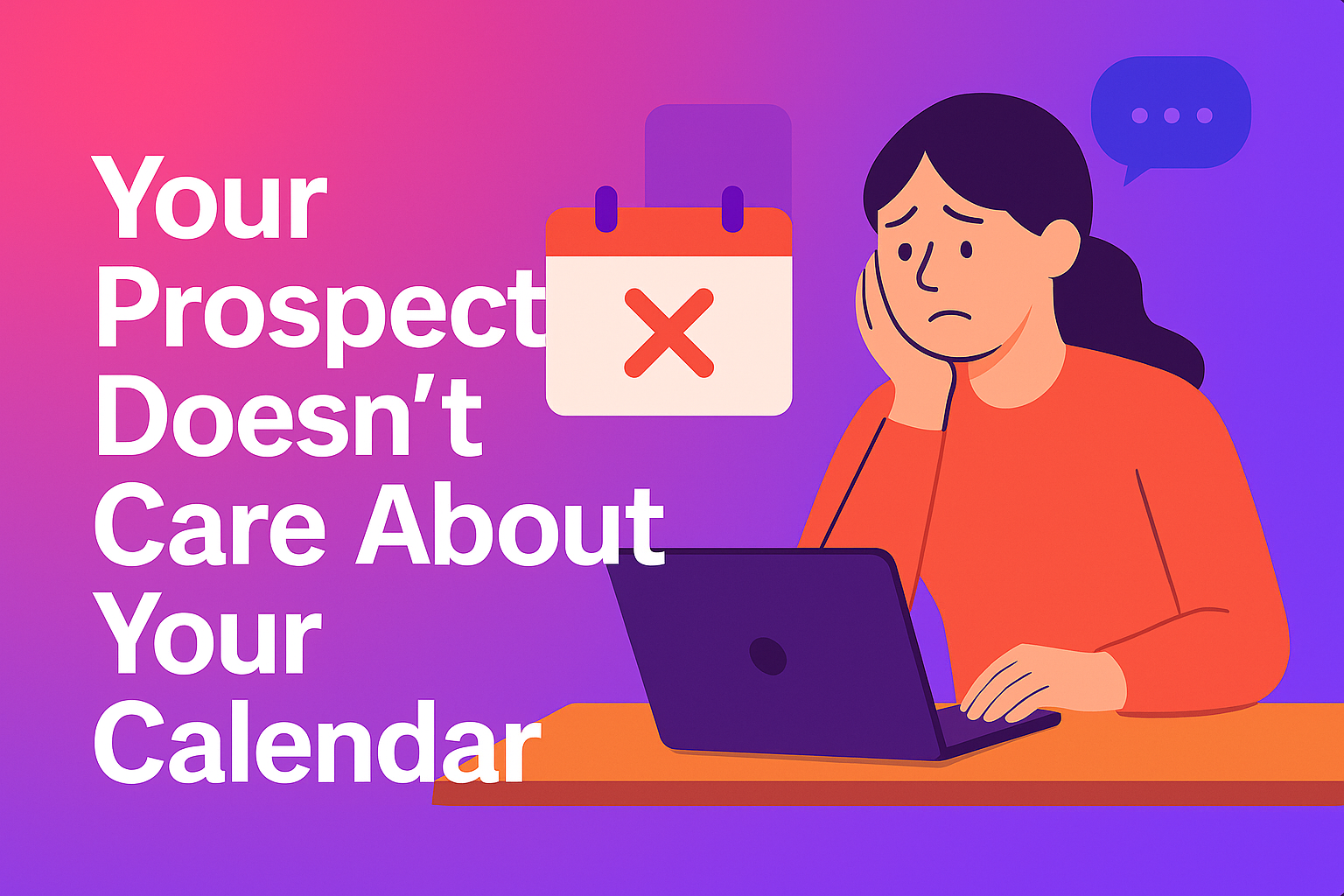If your company’s customer outreach is on the Google business suite, it’s all the more important that you know how to schedule a meeting in Google Calendar.
Google Calendar integrates seamlessly with your workspace applications, ensuring a centralized platform for managing your schedule, appointments, and meetings.
But your sales team can’t settle for the functionalities of Google Calendar as they are, to run a predictable GTM engine. Scheduling sales meetings on Google Calendar needs to translate into a frictionless buyer experience that reduces sales cycles and eliminates the hurdles that prevent high intent leads from evaluating your product ASAP.
So in this article, we will cover everything you need to know about how to schedule a meeting in Google Calendar and how you can use the same to schedule sales meetings with a fast and frictionless experience.
Here’s a quick rundown of what we will cover:
- Learning how to schedule a meeting in Google Calendar with a step-by-step guide.
- Getting more out of Google Calendar for sales apart from event scheduling and managing meetings.
- The limitations of Google Calendar as a standalone meeting and scheduling tool for sales professionals who need to handle a lot of demo calls.
- Understanding your current GTM process and leveraging Google Calendar to fix it. And how you can accelerate your sales cycles with a better meeting scheduling workflow.
How to schedule a meeting in Google Calendar
Step 1: Get a Google account
If you don't have one already, you can create one for free here as explained in this support article. After you're done creating an account, you can access Google Calendar through the web browser, mobile app, or desktop application.
Step 2: Schedule a meeting in Google Calendar
By default, Google Calendar is integrated with Google Meet. And as a part of their intuitive ecosystem, you can seamlessly schedule a Google Meet right from the Google Calendar.
Follow these steps:
- Open Google Calendar.
- Click on the "+ Create" button to create a new event (meeting).
- Enter the event details such as title, date, time, and a description of the meeting.
- In the "Add guests" field, add the email address of the participants you want to invite.
- Click on "Add Google Meet video conferencing" to generate a Google Meet link for the meeting.
- Click “Save” to schedule the meeting and send out the invites.
Check out options like busy hours to avoid getting meeting requests and add repeat meetings to be more systematic with recurring calls.
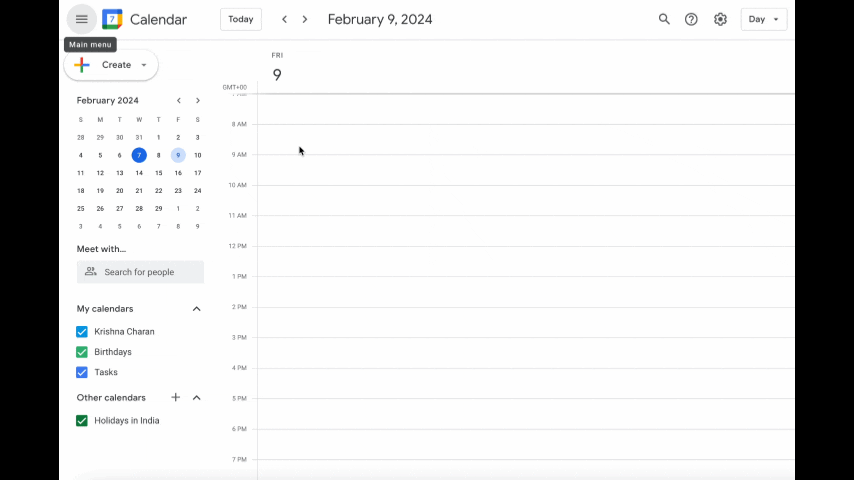
If you’re using a different video conferencing tool like Zoom or Microsoft Teams Meeting for calls, you can add them to your Calendar by clicking on the “+” icon in the right pane of your Google Calendar window.
Step 3: Customize your meeting settings
Google Calendar offers several customization options to adjust your meeting preferences. You can control options such as who can join the meeting directly or whether participants need to wait before getting accepted.
You can find these settings under “Event Details”, when you click on the “⚙️” icon.
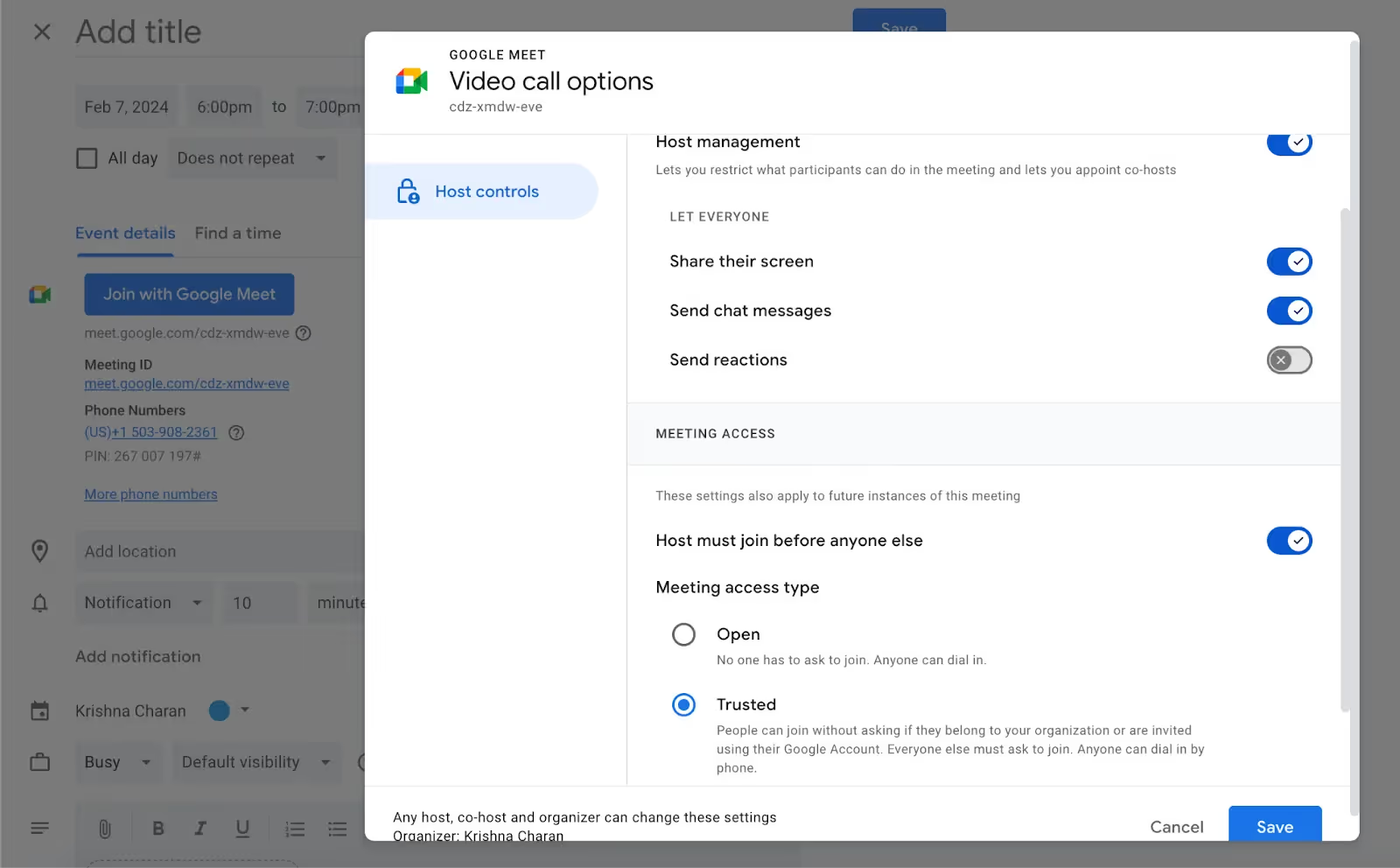
Step 4: Send meeting invites
Once your meeting is scheduled, Google Calendar will automatically send email invitations to the participants you've added. These invitations will include all the necessary details such as the meeting link, date, time, and any additional notes or collaterals you may have added.
Participants can simply click on the link to join the meeting at the scheduled time. The Google Calendar will also send reminders by default before the meeting starts. You can customize these alerts for any time before the meeting.
Best practices to follow after you schedule a meeting on Google Calendar
Here are some tips to get the most out of Google Calendar’s features:
1. Use meeting reminders to reduce no shows
Reminders that are personalized to the situation can drastically reduce meeting no shows. With Google Calendar you can create an email reminder as the meeting time or day nears.
Ideally, you’d want a multi-level meeting reminder nurture to keep your prospects engaged about the upcoming demo. But Google Calendar does not let you go this deep and personalize your reminders.
There’s no hard and fast rule about how the email nurtures for meeting reminders need to be but this is how marketers use RevenueHero to send Google Calendar meeting reminders:
3 days before the meeting
Give your prospects a refresher on your value prop and how your solution can address the specific challenge they are looking to solve.
PRO TIP: Ask if they have other use cases they want to be covered in the demo. It’s a good way to start a conversation.
1 day before the meeting
Nothing adds credibility like customer testimonials and case studies. Add your glowing G2 reviews, LinkedIn shoutouts, and case studies.
30 minutes before the meeting
A quick reminder email without any content-heavy copy and a meeting link with an option to reschedule.
2. Leverage appointment slots for in-person and internal meetings
You can create your own calendar slots using the “appointment slots” option in Google Calendar. You can either send the appointment page or add guests to the appointment so that they can pick a slot they want to.
However the limitations to this in the sales context is that your reps can’t add collaterals that nudge prospects to book a meeting or customize the meeting booking page that speaks your brand’s design.
3. Set clear meeting objectives
Before sending a Google Calendar meeting invite, sort out a clear agenda and action items for the meeting. Help your attendees come prepared for it.
4. Be mindful of time zones
Google Calendar lets you specify the time zones to avoid any confusion with the attendees. This is especially important while sending invites to global sales prospects and regional teams you work with internally.
5. Avoid last minute meeting invites
Plan your Google Calendar invitations well in advance to avoid cramming the schedules of your attendees. This might also secure a better rate of attendance and avoid no-shows.
6. Keep your schedule flexible for sales scenarios
You need to be open to rescheduling meetings if your sales prospects want to. With Google Calendar, you can give your prospects some control by allowing them to propose their favorable meeting time.
How to schedule a meeting in Google Calendar for your inbound and outbound requests?
Do you think about how your sales reps use Google Calendar in the sales context? Here’s how a conventional GTM workflow for meetings usually goes:
- Prospects fill a meeting request form on your website or ad landing page to take a product demo.
- SDRs run your internal lead qualification rules (such as ICP, company size, team size, revenue, etc.,) on these contacts to prioritize high intent leads.
- Based on the attributes of these contacts, a complex routing mechanism is overlooked by a manager to assign each lead to an SDR or AE manually.
- Now, your reps reach out to qualified prospects via email to set up a meeting.
- Once the prospect agrees to the meeting, your SDRs might send a meeting invite through Google Calendar or a third-party scheduler, so that prospects book their favorite slot.
- But many of them may not show up to the meeting because it’s already been a long sales cycle with too much waiting. The bigger challenge is to nurture them back to book another meeting through email outreach.
Your reps essentially spend a lot of time in back and forth emails and sales spreadsheets instead of reaching out to the prospect when their buyer intent is at its peak. The workflow is not too different for outbound either, except that your SDRs might repeat points 3 and 4.
Here’s where an instant meeting scheduling tool like RevenueHero can make Google Calendar meaningfully contribute to your sales pipeline by eliminating your sales reps’ manual tasks.
RevenueHero simplifies meeting scheduling flow in Google Calendar for both prospects and sales reps
Using Google Calendar as a standalone tool doesn’t really help your sales reps accelerate speed to meetings held, with all the manual pitfalls involved in getting prospects to agree to a meeting time.
With RevenueHero’s instant qualification, routing, and scheduling, you can help your reps manage their Google Calendar schedule and deliver a frictionless buyer journey across your GTM funnel.
1. Get prospects to schedule a meeting in Google Calendar right after they submit the demo request form
If you’re still showing a thank you page with a message like “Thank you for requesting a demo, someone will reach out to you soon” after a form submit, then consider your inbound meetings flow broken.
When prospects come across a “book a demo” CTA on your website, it’s fair to assume that they want to schedule a demo call, not wait for an email from a sales rep. Late sales response will only push your prospects to shop around in search of a more consistent buyer experience.
With RevenueHero, you can show your best rep’s calendar as soon as prospects submit their contact info on website forms.
Pro tip: Add lead qualification and routing conditions to your Google Calendar scheduling flow.
You can qualify and route meetings based on custom logic such as:
- Prospect background: Company size, region, time zone, industry, designation, etc.,
- Internal process: Team, time zone, expertise, account ownership (lead-to-account matching), etc.,
- Lead routing: Strict, flexible, and weighted round robin.
- Literally based on any values from the form or enriched data.
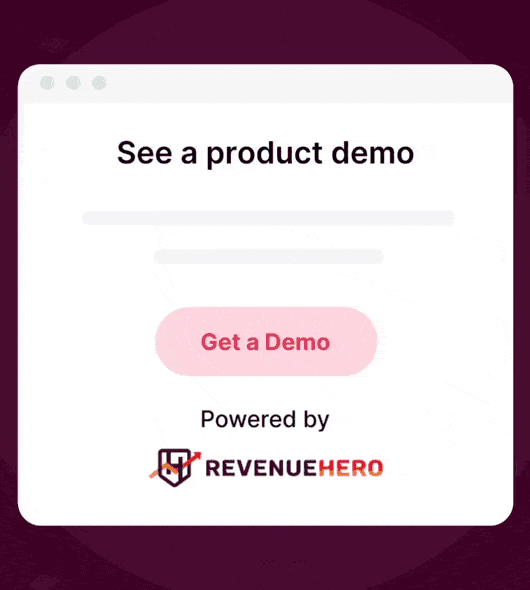
2. Get more demos from your outbound emails with embedded meeting slots
If you’re running an outbound campaign to a segment of hot leads, you can’t expect them to respond to you and discuss the ideal time to get into a meeting. You have to make it count right from the get go.
That’s why adding embedded meeting slots on emails can help prospects just click and book meetings in-line, without leaving the email tab.
RevenueHero can help your sales reps show their Google Calendar availability to prospects in the form of eye-catching time slots right within the email. Amidst an inbox full of pitch-slapping and little proactiveness, embedded meeting slots are a thoughtful (and beautiful) way to stand out and inspire action from the prospects.
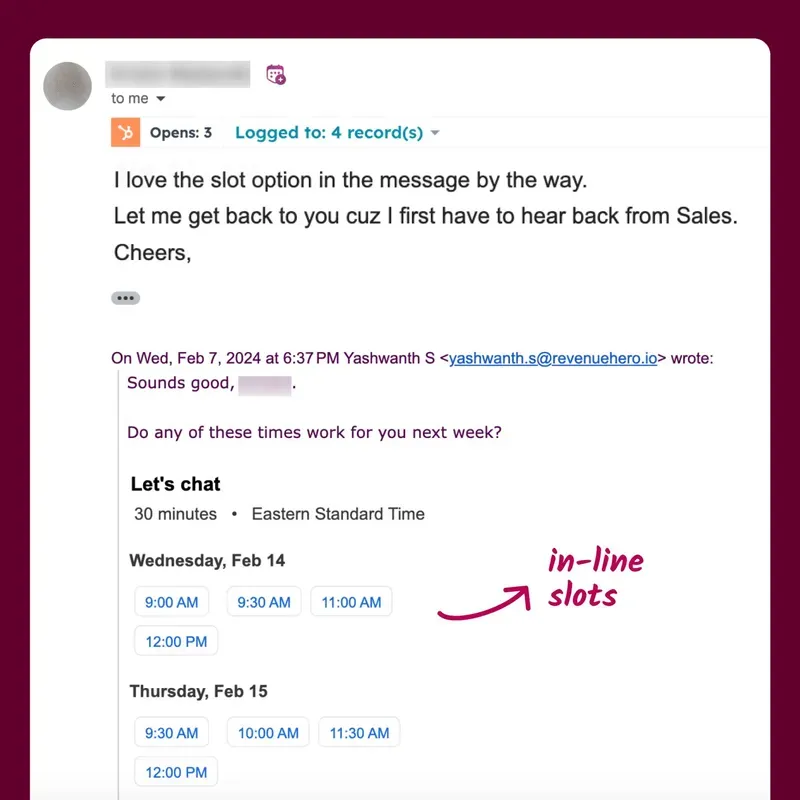
You also get benefits such as creating custom themes and adding collaterals to your PML pages. In fact, you can give them a rundown of what they could expect from the meeting over an embedded video right on the PML booking page.
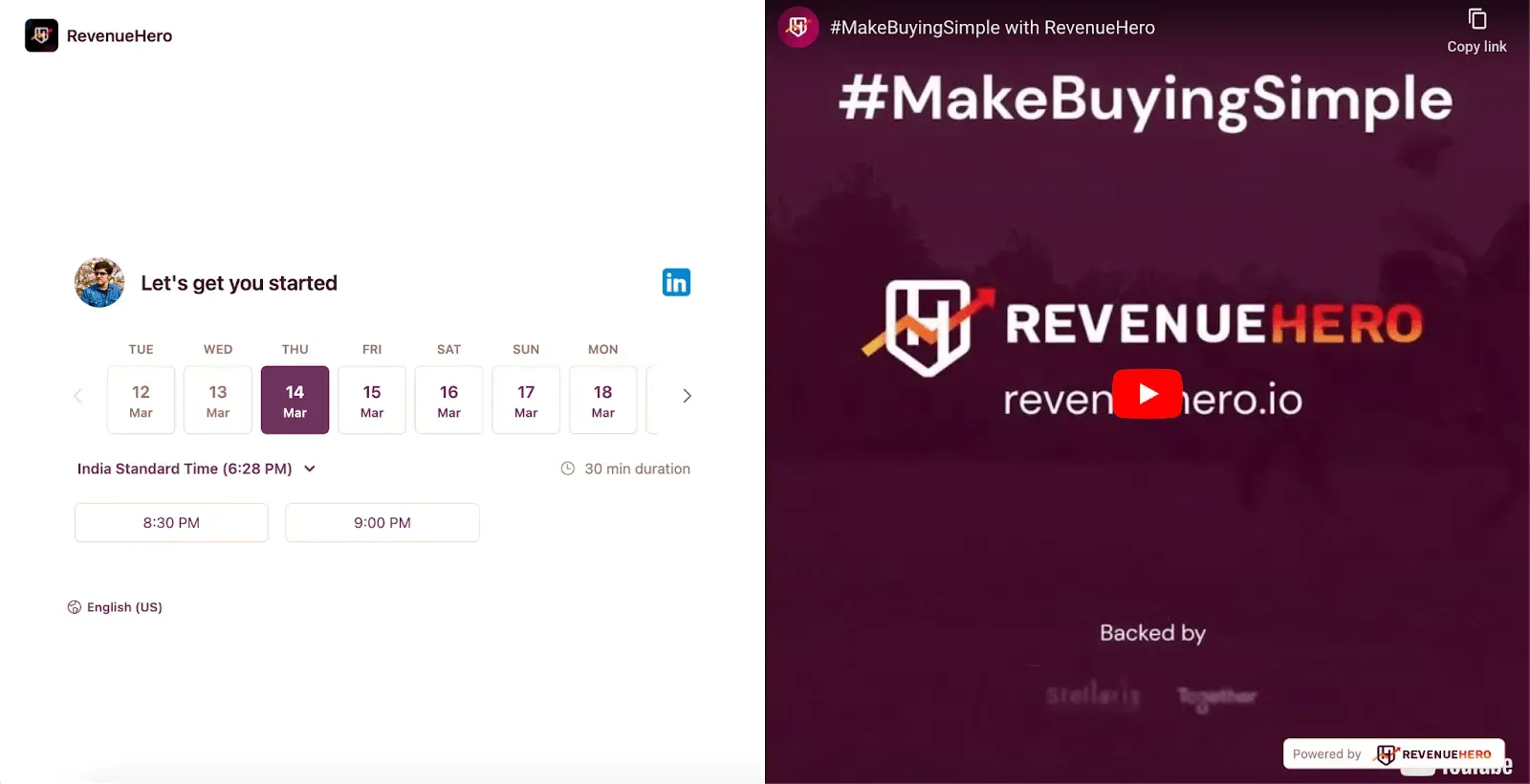
3. Route meetings to the best sales reps with 1-click magic links
Picture this. You’re sending a nurture sequence for qualified prospects who didn’t book a meeting (but filled up a demo request form). Do you think it’s wise to expect them to respond to you and discuss the ideal time for a call?
No, it’s not. Because it’s not up to your prospects to put the hard yards of agreeing to meetings over back and forth conversations, filling up a form with their contact details (that you already have), and then scheduling a demo.
Being a part of your inbound funnel should be rewarding to your prospects’ journey – and not be laden with additional hurdles to evaluate your product. What you need here is the right systems to nudge them to book a meeting instantly from your nurture emails.
With RevenueHero’s 1-click magic links, your sales reps can add meeting CTAs on emails that pick up existing contact properties from the CRM and help prospects automatically book meetings with the right sales rep.
Magic links also considers the rep who’s the contact/account owner in the CRM, in addition to the custom routing conditions that you set up.
Here are some of the granular insights that your GTM can pick up with RevenueHero’s campaign reports:
- Where did the demo come from? Was it a nurture email?
- Which nurture campaign created higher qualified demos?
- Did the campaign not succeed in this particular region?
- How is the SDR performance breakdown in campaigns that had a lot of meeting no-shows, meeting not booked, follow-up not booked, and other scenarios that affect pipeline?

4. Handoff prospects to AEs or book meetings on behalf of the right AE’s
Finding the right AE from a cluster of sheets is a tiresome job for sales reps. This is in addition to the actual prospecting work that SDRs need to be doing.
Relays by RevenueHero helps sales reps automate meeting handoffs to the right AE in just 2 clicks. With Relays, sales reps can add a meeting link with AE calendars to emails, and prospects to schedule meetings with the best AEs instantly.
Apart from the SDR-to-AE handoff on Google Calendar, the use cases can also be extended to AE-to-Implementation Specialist or AE-to-CSM handoffs.
5. Give your qualified hand raisers the option to book a meeting in-app
Sales-assisted PLG is hard. You can’t be entirely sure about the volume of meeting requests that might come in without a barrier to entry.
But here’s an experiment that can change the way you do PLG – give your product qualified leads (PQLs) the option to book a meeting right from your app.
Using RevenueHero, our customers set up in-app meeting widgets for specific prospects who might need a sales touch, based on their product usage.
This way, your PQLs can instantly schedule a meeting in Google Calendar when they’re stuck with adoption, or when they need to explore a higher subscription tier.
Here’s an example of Mailmodo’s in-app scheduler deployed using RevenueHero:

Generate more conversions with Google Calendar and RevenueHero
If you’re looking to turn Google Calendar into the perfect second fiddle for your reps, RevenueHero is just what you need.
Give your qualified prospects a meeting booking experience they will savor – and for your sales reps, a tool that helps them hit meeting quotas like clockwork without forcing them into manual tasks that (don’t even) belong in ops.
RevenueHero can save you hours and hours of insignificant grunt work every week. If you’re looking to help your GTM teams focus more on generating demand, prospecting, and building rapport with buyers, you know where to come!
Book a personalized demo with us now to learn more.
Let RevenueHero help your team turn high-intent users into booked meeting without slowing down your funnel.





